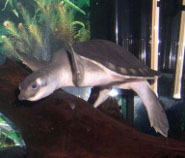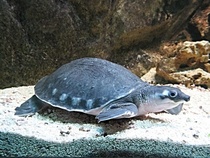Pignose Turtle
Pignose Turtle - Last Member of Ancient Turtle Family
 The pignosed or pignose turtle (Carettochelys insculpta) is the only remaining member of an ancient freshwater turtle family Carettochelys. They look more like a seagoing or marine turtle than a freshwater turtle, having flippers instead of feet. They live in Australia and New Guinea in bodies of freshwater like lagoons, rivers and ponds. Other local names for this unusual looking turtle include the pitted-shelled turtle, Fly River turtle, warradjan and the New Guinea plateless turtle.
The pignosed or pignose turtle (Carettochelys insculpta) is the only remaining member of an ancient freshwater turtle family Carettochelys. They look more like a seagoing or marine turtle than a freshwater turtle, having flippers instead of feet. They live in Australia and New Guinea in bodies of freshwater like lagoons, rivers and ponds. Other local names for this unusual looking turtle include the pitted-shelled turtle, Fly River turtle, warradjan and the New Guinea plateless turtle.
But another name you can call it is “vulnerable.” This is the classification a species receives right before being declared endangered. The pignose turtle is hunted for its meat and eggs; can die from water pollution or from injuries from motorboats and are illegally removed from the wild for the exotic pet market. It is estimated that the total world population of pignose turtles are half of what they were in the early 1990s.
General Appearance
As its name suggests, this turtle has an oddly-shaped nose. It is long and ends in a snout. This helps the turtle remain completely hidden underwater while breathing through the long snout. The turtle has four flippers instead of feet with two pale claws on each flipper. The shell or carapace is not hard but leathery. The pignose turtle is a dull olive grey with a pale underbelly and bottom half of the shell.
Males are slightly smaller than females. They also possess a slimmer tail than females. The largest adult females can weigh 66.13 pounds (30 kilograms), but the average weight is 44 pounds (20 kilograms.) The shell of an adult pignose turtle grows to the length of 28 inches (70 centimeters.) A pignose turtle needs to be between 14 to 16 years old before it reaches its full size.
Life Cycle and Behavior
Females come out to sandy land to lay eggs during the dry season (which varies upon where the turtle lives.) A female lays two batches or clutches every other year. They need a year to rest in between breeding. The clutch contains anywhere from 4 to 39 eggs. The eggs hibernate throughout the colder rainy season. When the dry season comes around again, they hatch all at once and enter the water, where they fend for themselves.
Pignosed turtles eat a wide variety of foods, including flowers, fruits, seeds, plants, insects and shelled crustaceans and fish. With luck, a pignosed turtle can live for 50 years.
Picture of the pignose turtle by Faendalimas, licensed under the Creative Commons Attribution-Share Alike 3.0 Unported license.
The Pignose Turtle is classified as Vulnerable (VU), considered to be facing a high risk of extinction in the wild.
Common names
Carettochelyidae in Romanian - română
Fly river turtle in English - English
Karetka novoguinejská in Slovak - slovenčina
Labi-labi moncong babi in Indonesian - Bahasa Indonesia
Miękkoskórek dwupazurzasty in Polish - polski
New guinea plateless turtle in English - English
Nieuw-Guinese tweeklauwschildpad in Dutch - Nederlands
Papua-Weichschildkröte in German - Deutsch
Pig-nose turtle in English - English
pig-nosed turtle in English - English
Pig-nosed Turtle, Pitted-Shelled Turtle, Warrajan in English - English
Pignose Turtle in English - English
Pitted-shell turtle in English - English
pitted-shelled turtle in English - English
Tortue à nez de cochon in French - français
Двуноктеста костенурка in Bulgarian - български език
เต่าจมูกหมู in Thai - ไทย

Original source: BioLib.cz
-Ivo Antušek -Author: Ivo Antušek
Permission: Some rights reserved
Family : Carettochelyidae
Genus : Carettochelys
Species : Carettochelys insculpta
Authority : RAMSAY 1887
